This Maharashtrian sabudana vada is super crispy and flavorful snack. Also known as Sago Vada, it is perfect for fasting days like Navratri and Mahashivratri. Learn how to make this easily at home with this step-by-step vegan/vegetarian recipe. Serve sabudana vade with coconut chutney or any of your favorite dips.
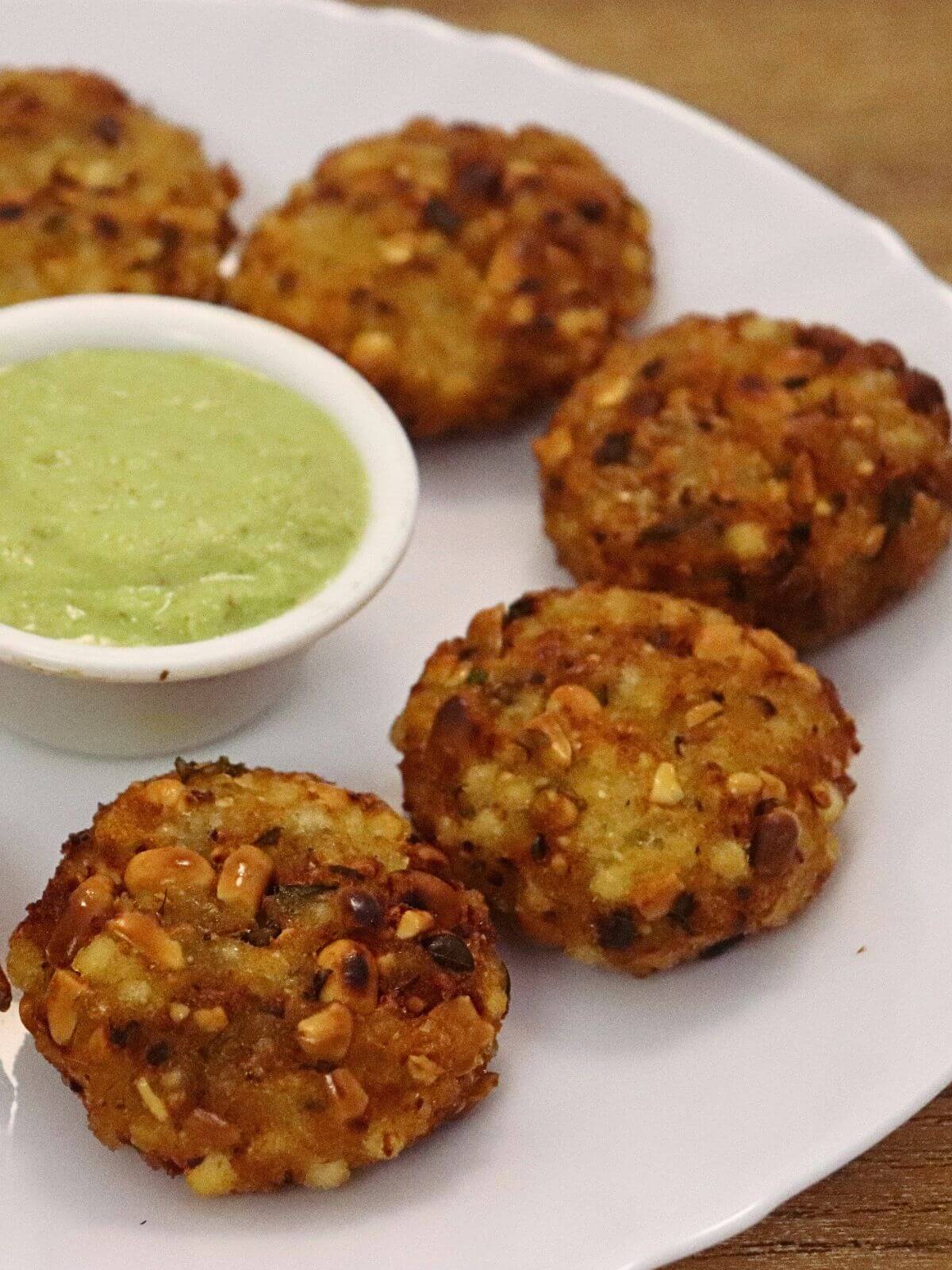
Jump to:
The word sabudana means tapioca/sago pearls. Vada simply refers to the patty or fritters. Making perfect sabudana vadas can be tricky for beginners. We've all been there - soggy vada, falling-apart vada, or sabudana vada bursting in hot oil while frying. But no worries! This recipe covers common sabudana vada mistakes and how to avoid them. We have shared tips to ensure your vadas emerge crispy and golden brown every time.
This Maharashtrian sabudanan vada is a crispy patty made from soaked sabudana (also Known as tapioca pearls/sago pearls), mixed with potatoes, peanuts, and a few Indian spices. My family loves these sabudana vada. The same ingredients are used to make Sabudana Khichdi and Sabudana Thalipeeth.
About this Sabudana Vada
Sabudana vada is a classic Maharashtrian street food that's totally addictive just like Maharashtrian chakli. You'll find these crispy golden-brown delights at almost every street corner in Mumbai, especially during breakfast or evening tea time. They're perfect for a quick and tasty snack, and trust me; one or two sago vada just won't be enough.
It's a family favorite, and my mom always makes it with a side of coconut chutney. Traditional Maharashtrian sabudana vada are deep-fried but don't worry if you're watching your oil intake. You can easily adapt this recipe to suit your preferences. For a healthier option, try shallow frying them in a pan or cooking them in an Appe pan. And if you have an air fryer, you can achieve that crispy texture with minimal oil there too.
This classic Maharashtrian snack tastes amazing. These crispy sabudana vade pair perfectly with spicy and tangy coconut chutney. I have shared chutney recipe in notes. My kids love these super crispy vadas. They never stop at just one or two. The incredible crunch and the delightful combination of flavors are truly out of this world. You simply must try this recipe; you won’t be disappointed.
Other popular Maharashtrian recipes
- Maharashtrian Sabudana Khichdi
- Sabudana Thalipeeth
- Maharashtrian Rava Ladoo
- Maharashtrian Chicken Sukka
- Kolhapuri Chicken Sukka
- Malvani Chicken Curry
Ingredients Notes
So ready to make these crispy sabudana vadas? If you've made sabudana khichdi before, you've probably got most of the ingredients on hand. The star of the show is definitely sabudana, or tapioca pearls, which give the vadas their perfect chewy texture. We'll add some crunchy peanuts and simple spices to round out the flavor.
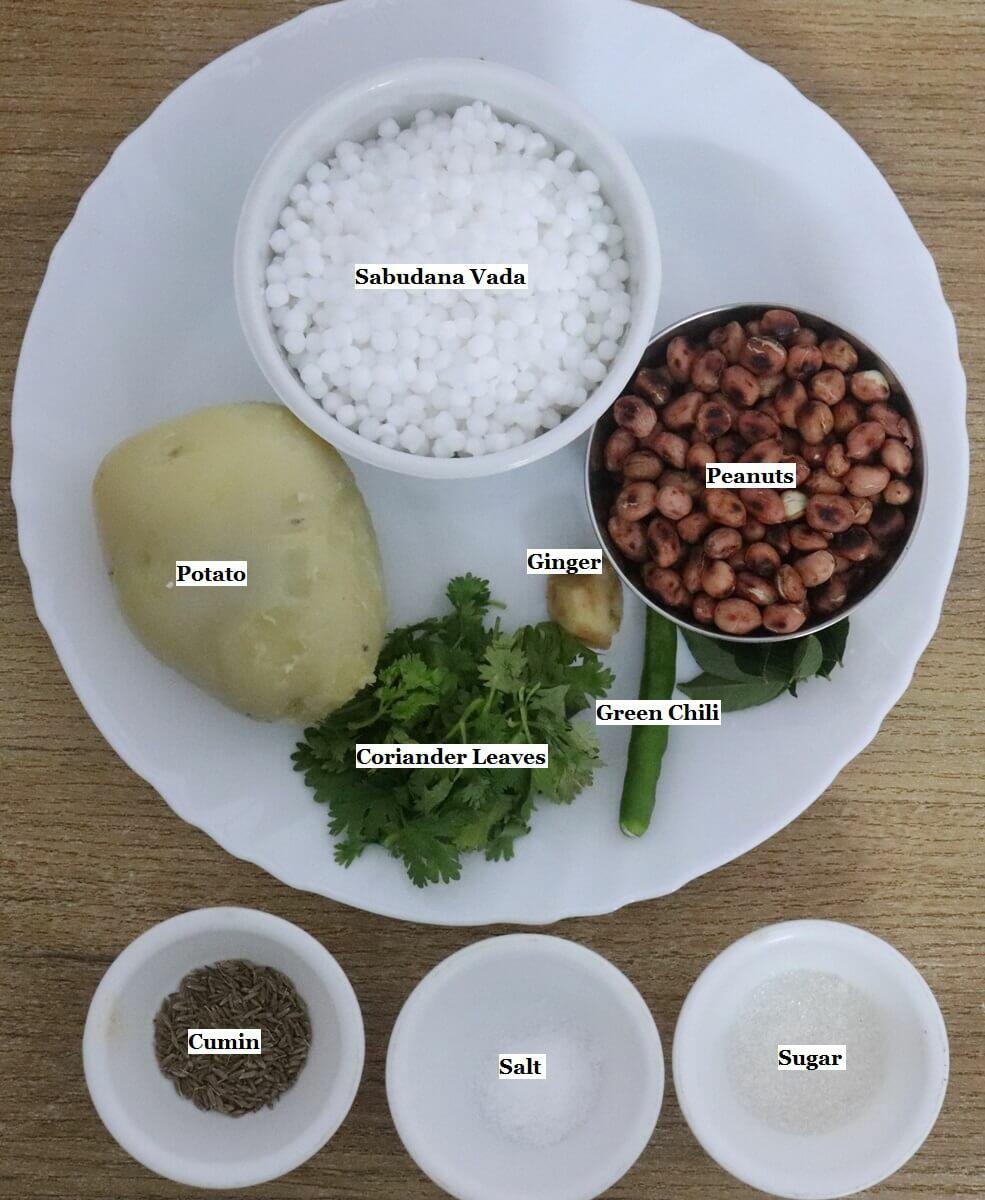
- Sabudana - Sabudana, also called tapioca pearls/sago pearls, are a must-have in any Indian pantry. They're super easy to find at your local Indian grocery store. Trust me, they're what give sabudana vadas that amazing crunch.
- Potatoes - To get these sago pearls to stick together and hold their shape, we use boiled potatoes. The potato's starchy magic is what helps us form those perfect little vada patties.
- Peanuts - For an extra crunch, roasted and roughly crushed peanuts are added to this sabudana vada. They not only give it a great texture but also help soak up any extra moisture, making sure your vada stays crispy and delicious.
- Flavoring - To season this crispy vada, a simple combination of green chilies, ginger, and cumin seeds is needed. For those following a fasting diet, replace regular salt with Sendha Namak (rock salt).
- Oil - You can use any cooking oil with a neutral flavor and a high smoke point. I used sunflower oil for this frying sabudana vadas.
- Herbs - Fresh coriander leaves and curry leaves add freshness to vada. Curry leaves are optional.
How to make Maharashtrian Sabudana Vada with Step by Step Photos
Soaking the sabudana
1) Rinse the sabudana thoroughly 2-3 times to remove excess starch. Soak it in water for 6 hours or overnight. The level of water should be just half-inch above the sabudana. Once the sabudana is soaked, keep it aside.
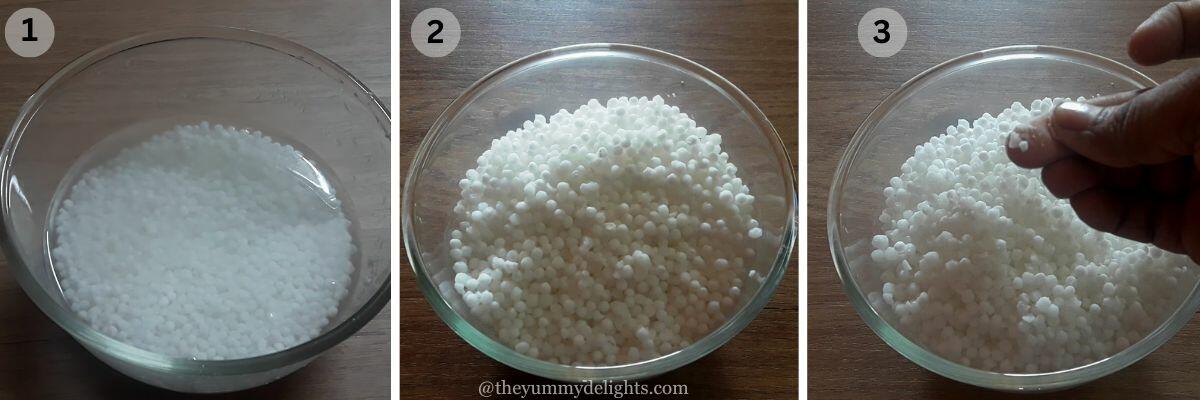
Cooking the potatoes - Next, cook potatoes. You can either pressure cook them for four whistles or boil them in a pan with enough water until cooked. Remove them to a plate. Let the potatoes cool completely, then peel them. Keep it aside.
Roasting & crushing the peanuts
First, let's roast those peanuts. Toss them into a heavy-bottomed pan over medium heat. Keep stirring until they turn a golden brown and you hear a few pops. Once they've cooled down completely, you can easily peel off their reddish skin. Grab a few roasted peanuts between your palms, and the skin will easily slip off. Repeat this process with the remaining peanuts. Once all the peanuts are rubbed, give the plate a good shake - the lighter skins will separate from the heavier peanuts. Simply remove the skins.

I prefer to use a mortar & pestle to crush it to make a coarse powder. For a quicker option, you can pulse them in a grinder, but avoid making a fine powder. Just one or two pulses should suffice.
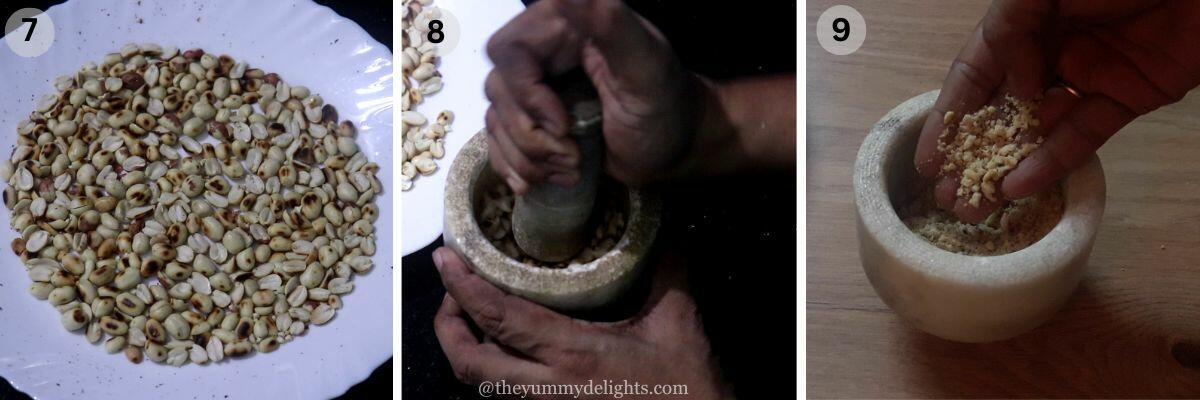
Making Sabudana Vada Dough
In a mixing bowl, first, mash the potato with your hands or use a masher. Then add soaked sabudana, crushed peanuts, green chilies, ginger, cumin, curry leaves (optional), chopped coriander leaves, sugar, & salt. Mix it all together until well combined. Slightly mash the ingredients while mixing them as it creates a better binding. Do not break the sabudana too much while doing this process. The sabudana vada dough is ready.
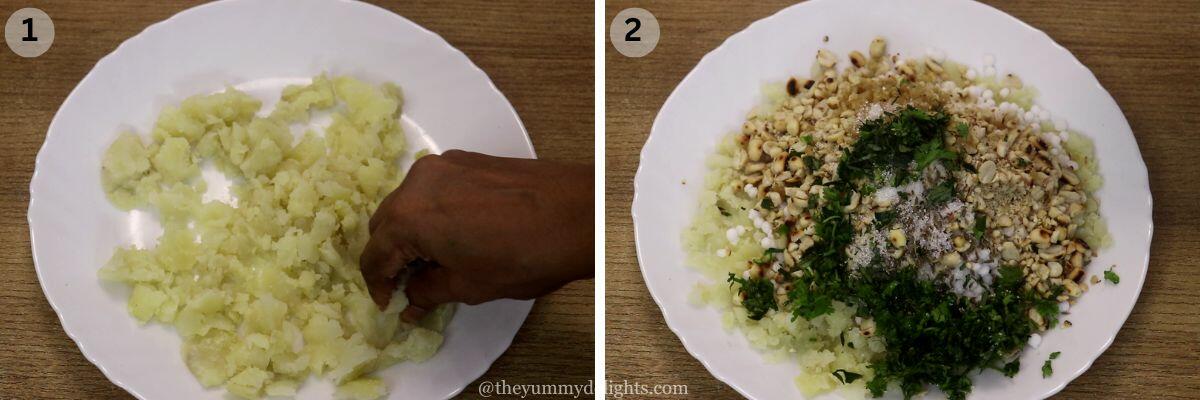
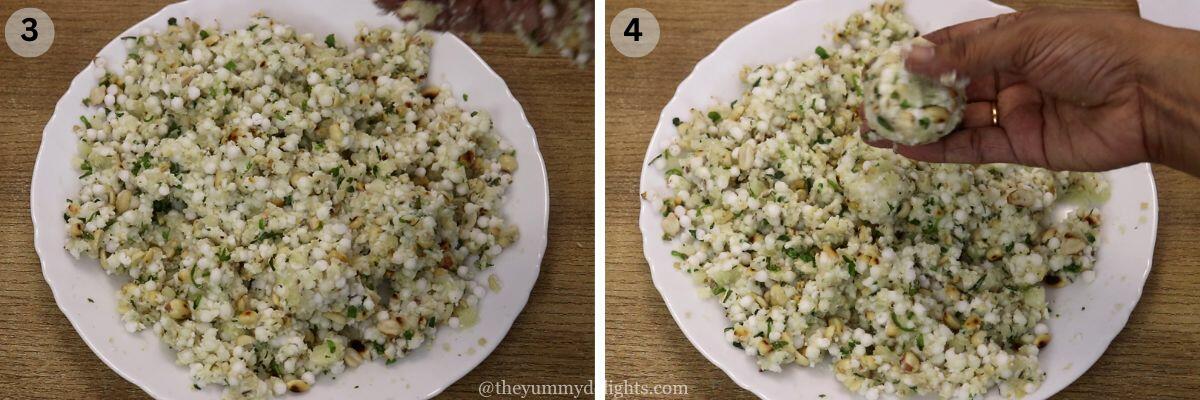
Shaping and frying sago vada
Clean your hands. Apply a little oil to your palms or wet them with water. Take a small portion of the prepared dough. Shape the mixture into a round ball and slightly flatten it with your thumb. Make sure all the sides are properly sealed and are even sized. Repeat this process for all the sabudana vada. Avoid making them too large, as they might remain undercooked or break apart while frying.
Frying the sabudana vada
Heat oil in a pan over medium heat until it's hot enough. Carefully slide the sago vada into the hot oil. Don’t overcrowd the pan and let it cook undisturbed until golden brown around the edges. Gently flip it over and fry the other side until crispy and golden. Drain on a paper towel-lined plate to remove excess oil.
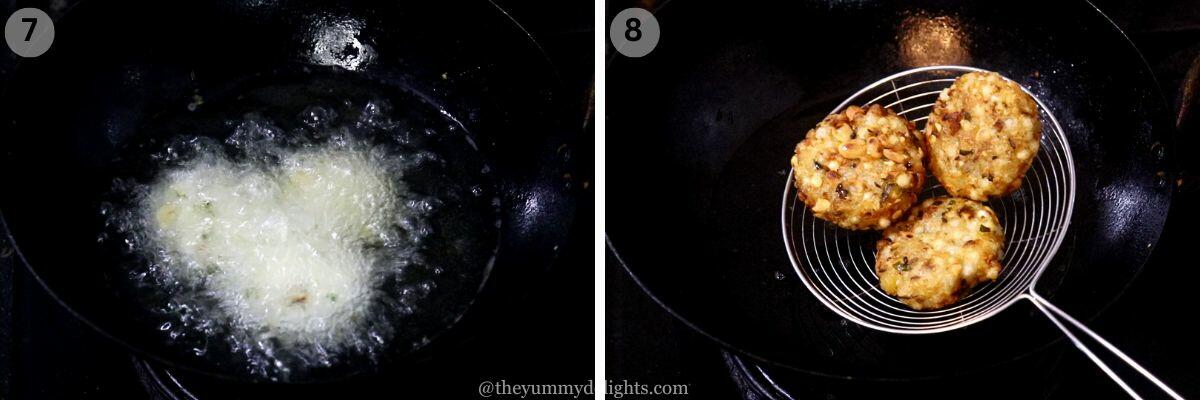
Tips to make the Best Sabudana Vada Recipe
1) Soaking Sabudana (Tapioca/Sago Pearls) - The soaking time for sabudana can vary. Some types only need a couple of hours, while others require 6-7 hours of soaking. To ensure perfect sabudana vadas, I recommend soaking them overnight. In the morning, the pearls should be soft and easily mashed between your fingers. If not, they need more time.
A key tip: Use just enough water to cover the sabudana by about ¼ inch. Too much water can make the sabu vada soggy. If you find the pearls are still hard after overnight soaking, simply sprinkle a little more water and let them sit for a few hours.
2) Sabudana Vada Mixture Consistency - Well, the secret to super crispy sabudana vadas is all about keeping the sabudana mixture dry. Too much moisture is a big no-no because it can make your sago vada soggy.
Another tip - Don't overcook the potatoes. Overcooked potatoes can make the sabudana vada mixture soggy as they release water and ruin the crispiness of vadas.
3) Frying Your Sabudana Vada - Make sure your oil is hot before dropping sabudana vadas in it. Don't crowd the pan, or they won't cook evenly. If you prefer a lighter version, you can always shallow fry them too.
4) If the mixture is too sticky to shape into vada, lightly oil your palms or simply wet them with water before forming the patties.
Frequently Asked Questions
It's super frustrating when your sabudana vada bursts in the hot oil. There are a few reasons why this might happen:
1) Too much moisture: If your soaked sabudana has water content in it, the extra water can cause the vada to burst in hot oil. Make sure your soaked sabudana is completely dry. Squeeze a sabudana pearl between your thumb and finger to ensure it is completely dry.
2) Oversized vadas: If you pack too much mixture into the sabudana vada, they can expand and burst when they hit the hot oil.
1) Make sure your sabudana pearls are soaked perfectly – soft but not mushy. Oversoaked pearls can lead to soggy vadas.
2) Also, check if your potatoes are not overcooked. They should be soft but not mushy.
3) And lastly, the correct oil temperature. Too low and they'll soak up oil, too high and they'll burn before cooking through.
To test the correct temperature - Drop one sabudana pearl in hot oil, if it comes up and is golden brown, the temperature is right.
Maharashtrian sago vada tastes delicious when combined with coconut chutney & a cup of hot ginger tea. You can also serve it with green coriander chutney or plain yogurt.
Pair it with Tomato ketchup, kids love this combination. (if not serving during the fasting period).
To make it crispy try to make the sabudana mixture dry.
1) Do not over-boil the potatoes. If potatoes are overcooked then they will add moisture to the sabudana mixture.
2) The sabudana pearls need to be soaked perfectly. If it is too soft or soggy (it happens when you add more water to soak the sabudana) then it will add moisture to the sabudana mixture.
3) Fry the sago vada in medium hot oil. The oil for frying the vada should not be too hot or too cold.
4) Fry them over medium heat, flipping once or twice, so that sabudana is crispy outside & cooked well from inside.
Sago Vada Variations
- Make Sago Donuts - Shape it like donuts kids love them.
- Make them in Appe pan - Just shape them into round balls and fry them in Appe pan. You can stuff spicy coconut chutney inside these balls for a surprise.
If you try this recipe, please leave a comment and rating below. We'd love to hear your feedback.
For any questions or concerns while making this recipe, please get in touch with me directly at nayakprety@gmail.com. I'll try my best to respond promptly.
And, consider following me on social media so we can stay connected. I’m on Facebook, Pinterest, and YouTube!
Recipe Card

Sabudana Vada Recipe (Sago Vada)
Video

Equipment
- Heavy bottom pan
Ingredients
- 1 cup sabudana (sago pearls/tapioca pearls)
- ¾ cup peanuts (groundnuts)
- 1 big potato (boiled and peeled) ½ cup mashed potatoes
- salt
- 1 green chili, finely chopped finely chopped
- 1- inch ginger, finely chopped
- 1 teaspoon cumin
- 1 teaspoon sugar
- 8-10 curry leaves (optional)
- 1 teaspoon lemon juice
- 2 tablespoon finely chopped coriander leaves
Instructions
Soaking The Sabudana
- Rinse the sabudana thoroughly 2-3 times to remove excess starch. Soak it in water for 6 hours or overnight. The level of water should be just half-inch above it. Once the sabudana is soaked, keep it aside.
- Cooking the potatoes - Next, cook potatoes. You can either pressure cook them for four whistles or boil them in a pan with enough water until cooked. Remove them to a plate. Let the potatoes cool completely, then peel them. Keep it aside.
Roasting the Peanuts
- First, let's roast those peanuts. Toss them into a heavy-bottomed pan over medium heat. Keep stirring until they turn a golden brown and you hear a few pops. Once they've cooled down completely, peel off their skin.
- I prefer to use a mortar & pestle to crush it to make a coarse powder. For a quicker option, you can pulse them in a grinder, but avoid making a fine powder. Just one or two pulses should suffice.
Making Sabudana Vada Dough
- In a mixing bowl, first mash the potato with hands or use masher. Then add soaked sabudana, crushed peanuts, green chilies, ginger, cumin, curry leaves (optional), chopped coriander leaves, sugar, & salt. Mix it all together until well combined. Slightly mash the ingredients while mixing them as it creates a better binding. Do not break the sabudana while doing this process. The mixture is ready.
Shaping and Frying Sago Vada
- Take a small portion of the prepared mixture. Shape the mixture into a round ball and slightly flatten it with your thumb. Make sure all the sides are properly sealed and are even sized. Repeat this process for all the vadas. Avoid making them too large, as they might remain undercooked or break apart while frying.
Frying the Sabudana Vada
- Heat oil in a pan over medium heat until it's hot enough. Carefully slide the vada into the hot oil. Don’t overcrowd the pan and let it cook undisturbed until golden brown around the edges. Gently flip it over and fry the other side until crispy and golden. Drain on a paper towel-lined plate to remove excess oil.
Notes
- Soaking Sabudana (Tapioca Pearls) - The soaking time for sabudana can vary. Some types only need a couple of hours, while others require a full night. To ensure perfect sabudana vada, I recommend soaking them overnight. In the morning, the pearls should be soft and easily mashed between your fingers. If not, they need more time.
- To make coconut chutney - Add ½ cup coconut, ¼ cup tightly packed coriander leaves, ½ teaspoon cumin, 1-2 green chilies, salt, and lemon juice in a blender jar. Add water and blend. Coconut chutney is ready.
- Use just enough water to cover the sabudana by about ¼ inch. Too much water can make the sago vada soggy. If you find the pearls are still hard after overnight soaking, simply sprinkle a little more water and let them sit for a few hours.
- Sabudana Vada Mixture Consistency - The secret to super crispy sabudana vadas is all about keeping the mixture dry. Too much moisture is a big no-no because it can make your Maharashtrian sabudana vade soggy.
- Don't overcook the potatoes. Overcooked potatoes can make the sabudana vada mixture soggy as they release water and ruin the crispiness of vadas.
- Frying Your Sabudana Vada - Make sure your oil is hot before dropping sabudana vada in it. Don't crowd the pan, or they won't cook evenly. If you prefer a lighter version, you can always shallow fry them too.
Nutrition
Nutrition information is automatically calculated, so should only be used as an approximation.

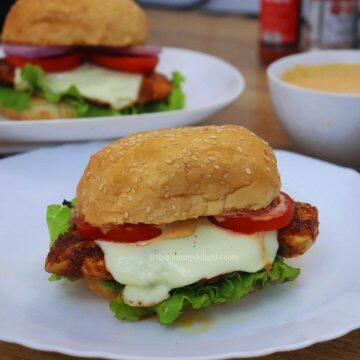
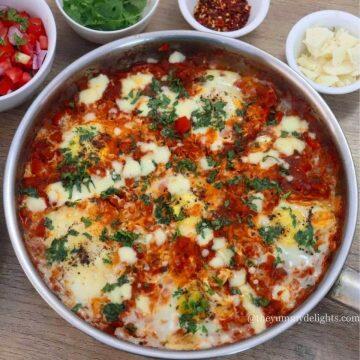
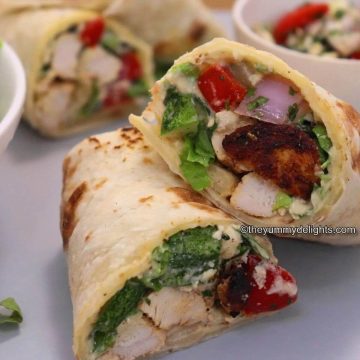
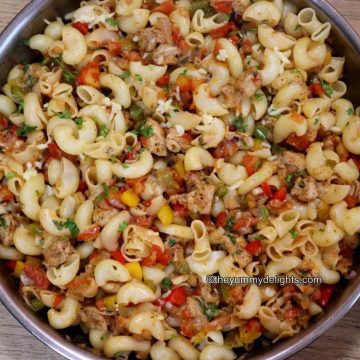
Preeti
If you've struggled with soggy sabudana vadas that are too oily, trust me, this method gives you perfectly crisp vadas that are light and crispy, and they soak less oil than any other recipe. Try this recipe once, and you won't be disappointed.